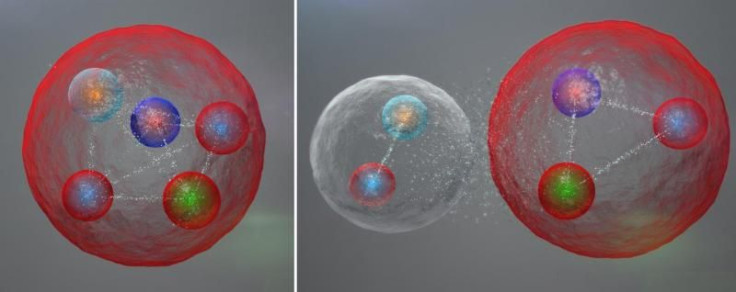CERN's Large Hadron Collider Discovers The Elusive 'Pentaquark'

On Tuesday, scientists at CERN’s Large Hadron Collider (LHC) announced the discovery of an exotic new class of particles -- the “pentaquark.” The particle, which essentially represents a new form of matter, was first detected by the LHCb experiment during the collider’s previous run from 2009 through 2013.
“The pentaquark is not just any new particle,” Guy Wilkinson, spokesman for CERN’s LHCb experiment, said, in a press release. “It represents a way to aggregate quarks … in a pattern that has never been observed before in over 50 years of experimental searches.”
Quarks, the fundamental particles that make up protons and neutrons, come in six different “flavors” -- up, down, strange, top, bottom and charm. Each quark has an anti-matter equivalent known as antiquark. Both protons and neutrons -- contained within the nucleus of an atom -- are made up of three quarks bound together.
The 1964 model that first proposed the existence of quarks also postulates the existence of a pentaquark -- composed of five quarks. In 2002, several labs reported finding evidence of this particle. However, these discoveries were later undermined by other experiments, which eventually led it to be pronounced a statistical mirage in 2005.
“It’s as if the previous searches were looking for silhouettes in the dark, whereas LHCb conducted the search with the lights on, and from all angles,” the researchers who analyzed data from the LHCb experiments said in the statement.
Physicists at CERN first saw a signal in 2012 hinting at the unexpected appearance of two extremely short-lived objects weighing 4.38 gigaelectronvolts and 4.45 gigaelectronvolts -- much heavier than a proton -- during the decay of subatomic particles known as ‘Lambda B’ baryons, which are made up of three quarks. After measuring the new objects’ properties, the researchers concluded that they corresponded to that of a pentaquark.
The five quarks in this particle may either be tightly bound, or assembled into a meson -- one quark and one antiquark -- and a baryon weakly bound together.
Although further studies would be needed to find out how these quarks are bound together in the pentaquark, the discovery is a significant step toward understanding the strong nuclear force -- a fundamental force that holds subatomic particles together within a nucleus.
“Studying its properties may allow us to understand better how ordinary matter, the protons and neutrons from which we’re all made, is constituted,” Wilkinson said in the statement.
© Copyright IBTimes 2024. All rights reserved.






















